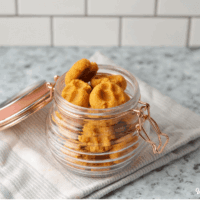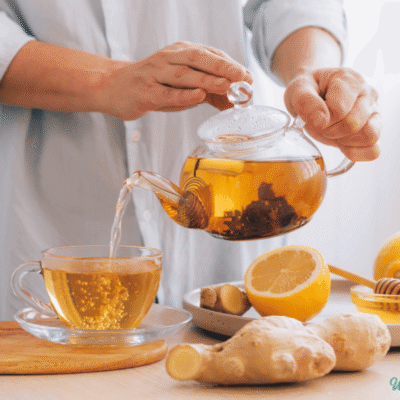Our family prioritizes healthy, whole foods, so why not do the same for our pets? To my children, pets truly are part of the family. It was their idea to make homemade dog treats for our dog. And now they wanted to make homemade cat treats for our cats, Penelope and Tiger, too (“to be fair”).
Like the dog treats we made for Daisy, these homemade treats contain healthy ingredients cats love. They’re simple to make and store really well in the fridge. Our cats don’t even seem to mind if we don’t heat them up before giving them one.
These treats are part of the Natural Cat Care & Holistic Alternatives we use to keep our furry friends healthy. Just remember these are treats though and not intended to be a meal replacement.
Homemade Cat Treats: What You Need
There are so many ways you could make this recipe your own. I’d love to hear how you adapt it for your pets in the comments. Here’s what we used and why:
Coconut Oil
Coconut oil is a definite staple at our house, for both humans and pets. For cats, it’s a great source of healthy fats, especially the medium-chain fatty acids that support digestion and healthy skin. I use it in these homemade treats since coconut oil has natural antibacterial and antifungal properties.
Cats are naturally carnivores so their systems are designed for fat-based energy. Coconut oil is a nourishing addition that mimics the natural fats they’d get from prey in the wild.
Coconut Flour
Coconut flour is one of my favorite grain-free alternatives when I’m baking for the family. So it made sense to use a little in treats for our cats too. It’s high in fiber, gentle on digestion, and helps everything hold together without using grains. Plus, it blends really well with the coconut oil and eggs, creating a soft texture our cats love.
Cooked Sweet Potatoes
While cats don’t need carbs, sweet potato adds some extra nutrients, especially vitamin A and fiber. It also gives a soft, easy-to-digest base for the treats. I’ve found that when used in moderation, it can be a nice way to add variety and a soft texture.
Gelatin Powder
I use gelatin in a lot of homemade recipes, from marshmallows to gummies. It turns out it’s great for pets too. Gelatin is rich in amino acids like glycine and proline, which support healthy skin, fur, and joints. I like to use a bulk grass-fed gelatin to keep it budget-friendly, but any clean gelatin will work. It also helps bind the treats and gives them a chewy texture our cats enjoy.
Tuna (or Sardines)
When in doubt, tuna is always a hit! Most cats can’t resist it. Canned fish like tuna or sardines are not only protein-rich, but they’re full of omega-3 fatty acids that support brain, skin, and coat health. In our house, sardines are a favorite. They’re small, have less mercury, and are packed with nutrients.
Egg
Eggs are a complete protein source, and full of healthy fats and fat-soluble vitamins. I use them in homemade pet treat recipes because they help everything hold together while adding a big nutritional boost. If your cat tolerates eggs well, they’re a simple and affordable way to add some extra nourishment.
I baked these on a baking sheet with natural parchment paper to avoid sticking. They store well in a glass jar in the fridge.

Homemade Cat Treats
-
Peel, cube, and cook the sweet potatoes until tender.
-
Preheat the oven to 350 degrees.
-
Mix all ingredient in a medium size bowl. Use a fork to mash everything together until evenly mixed and until all large pieces of fish and sweet potato are mashed up.
-
Add a little extra coconut flour if needed to get a dough that’s roughly the consistency of play dough.
-
Roll into 1 inch balls and mash down with a fork to form little “cookies.” I used my fingers on some to make a paw print shape.
-
Bake for 20 minutes or until lightly browned.
-
Remove from heat and let cool completely.
Nutrition Facts
Homemade Cat Treats
Amount Per Serving (1 cat treat)
Calories 49
Calories from Fat 27
% Daily Value*
Fat 3g5%
Saturated Fat 3g19%
Trans Fat 0.001g
Polyunsaturated Fat 0.1g
Monounsaturated Fat 0.2g
Cholesterol 6mg2%
Sodium 23mg1%
Potassium 47mg1%
Carbohydrates 3g1%
Fiber 1g4%
Sugar 1g1%
Protein 3g6%
Vitamin A 1611IU32%
Vitamin C 0.3mg0%
Calcium 6mg1%
Iron 0.2mg1%
* Percent Daily Values are based on a 2000 calorie diet.
Store in the refrigerator for several weeks or in the freezer for several months.
Quality Cat Food
Many of you have asked what cat food we use. I’ve tried different brands over the years and even experimented with making our own. Ultimately, I prefer to leave this in the hands of the experts. We now alternate between a variety of grain-free cat foods (wet, never dry).
Have you ever made homemade treats for your pets? What are their favorite ingredients? Leave a comment and let us know!





